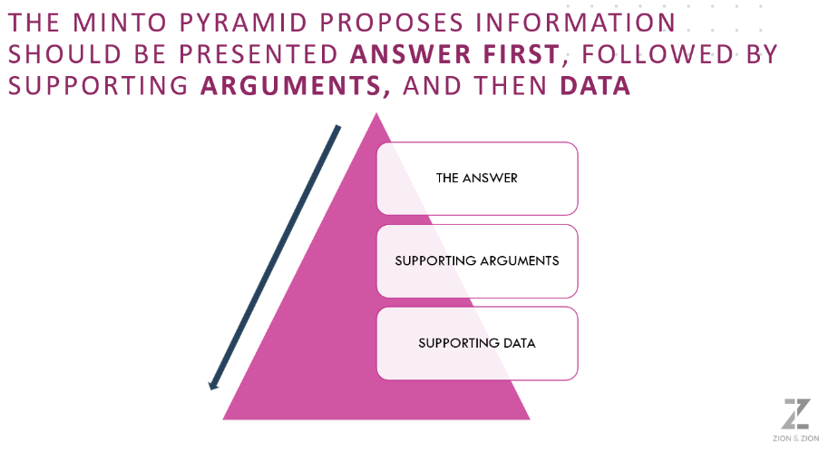Presentations are an integral part of any agency/client relationship. They must be clear, compelling, concise and of course, accurate. Two principles that are useful in presentations are The Minto Pyramid Principle and storytelling.
The Minto Pyramid Principle focuses on presenting the main actionable points upfront then supporting your conclusion with detailed arguments and underlying data. When you state your “answer” or main point first, you have captured your audience’s attention upfront. Then, presenting supporting information to justify your recommendation leaves nothing unanswered.
The Minto Pyramid Principle
The Minto Pyramid Principle is a structured approach to organizing and communicating ideas in a clear and logical manner, which is especially useful for presentations. The Minto method of organizing a presentation can be summarized like this:
- Start with your key message. Begin your presentation by stating your main message or conclusion upfront. This will provide a clear framework for the rest of your presentation.
- Structure your ideas into a pyramid. The Minto Pyramid Principle suggests that you should organize your ideas into a pyramid, with your main message or conclusion at the top, followed by supporting data underneath.
- Group similar ideas together. Once you’ve identified your key message and supporting information, group similar ideas together and organize them in a logical order. This will make it easier for your audience to follow your presentation.
- Use data to support your ideas. It is critical that your logic and arguments are clear and easy to follow. Using facts or data strengthens your points.

Presenting Fact-Heavy Data More Clearly
One example of a highly technical and data-heavy discipline where the Minto Pyramid Principle could be helpful is digital media. Digital media, such as paid search, can be difficult to communicate to the average person, as it contains multiple concepts and complex data. For example, there are numbers related to impressions, clicks, conversions, cost, conversion value, and ratios like impression share, ROAS, clickthrough rates and more. Each of these data points carries meaningful information about the performance of the campaigns. Typically, when it is time to report results to a client, the numbers are usually presented in the form of charts or graphs, leaving the client to interpret the meaning. This often leads to information overload and confusion. Even if the information is presented in a visually appealing format, it may still be difficult for a client to grasp and understand the recommended course of action. Using storytelling and the Minto Pyramid in presentations makes the information easier to understand for those that are less technical or have a hard time understanding data.
Putting The Minto Pyramid To Work
Let’s illustrate using a home-services client of ours as an example. Our client had previously insisted on pursuing a more expensive digital strategy that they believed would pay off with more profitable leads. Our experience had shown that the strategy would result in much higher costs and few additional viable leads. We performed a trial run of the requested campaign to test its performance, and it performed as we anticipated.
When presenting our findings and recommendations of the trial up front by utilizing the Minto framework—i.e. we didn’t show endless amounts of data and later build to a conclusion. Instead, we started with the conclusion. And in so doing, we gained the client’s attention from the outset. In the end, they agreed with our assessment and recommended strategy moving forward. If we had presented the data upfront and left them to interpret the information, the message may not have been as clearly conveyed. Instead, we started the presentation with the answer/conclusion: The tested strategy is being outperformed by all other strategies currently being executed. Following the answer, we presented only the essential facts to support this conclusion, so the presentation wasn’t clouded with irrelevant data, and the client wasn’t overwhelmed.
Clear Messaging Offers Time Savings
Another advantage of using the Minto Pyramid to organize a presentation is significant time savings. For example, in a Statement of Work presentation to a potential client, we used the Minto Pyramid to present the structure of what our engagement would look like for both parties. We first presented the answer: the proposed cost. Yes, we started with the cost. We didn’t talk and talk and talk in hopes that when we got to the cost, it would be justified.
We started with the cost. Gutsy? Maybe. Effective? Definitely.
This is ideally what the client wants to know. Let’s face it, that’s what they’re waiting for. And until you tell them the cost, they aren’t really going to be giving you 100% of their attention.
The rest of the presentation served to tell the story of each element of the engagement and how each part adds value. The entire presentation took only fifteen minutes, and it told a story that was brief and engaging, much like a concise “elevator speech.” More conventional presentations contain slide after slide of irrelevant details and dollar figures for each service, laddering up to the final reveal, the sum of all the figures in all the previous slides -the cost to the client. This is not only tedious but risks boring key stakeholders who are interested only in the final number. A proposal that traditionally could take an hour or more can be condensed down to about 15 minutes and at the same time, be more compelling, engaging, and effective.
Conclusion
The Minto Pyramid Principle is powerful. It provides clarity, saves time, and captures your audience’s attention. However, it takes practice, and it takes courage until you build the experience to have confidence that the Minto answer, is the right answer.
